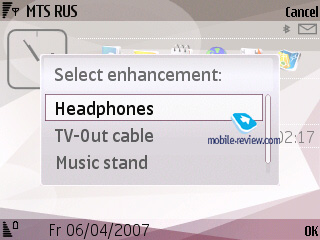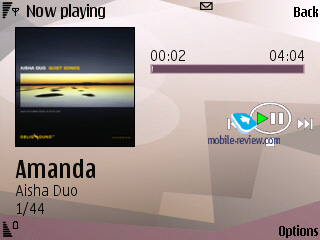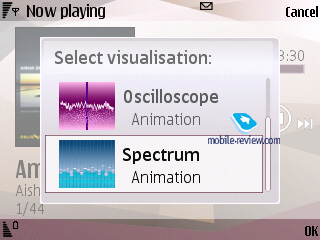Nokia N95 is indisputably the most hyped novelty of this season and sets off to be its segment’s one of the most popular offerings. That is why we are now stepping aside from our usual review structure and instead taking a closer look at the major constituents of the handset, and today we are kicking off with the music department.
Music department. It may be safely said that Nokia N95 is among the music-minded smartphones by Nokia, even though the manufacturer itself does not deliberately spotlight that, preferring to push all features of the device. The package the N95 comes in indicates that this solution will cater for music lovers as well as everybody else.
The left-hand side houses a 3,5 mm audio jack, used for plugging in custom earphones, i.e. those you have grown fond of. The bundled headphones simply radiate style, with the armored cable in transparent braiding. There is a plastic clip on the wire, so that you can always shorten the cord by hooking the cable with it. The headphones that come boxed with the N95 are not in the running for the best-sounding earphones around, being inferior both to those coming with Nokia 3250 and Nokia N91. If you want to make the most of this device, you should better have custom headphones plugged in.


The remote control comes packaged with the phone and bears strong resemblance to that of Nokia N91 – with its help you can manage playback by rewinding, pausing, playing tracks and also answer a call with the dedicated button. The sides are loaded with volume rocker and Hold slider respectively. As someone would say, it lives up to what we have come to expect from the company, and on top of all that, the front fascia of the remote is made of metal. Clipping the remote on your clothes was never an issue.


I should emphasize it again, that the handset’s big attraction is the 3,5 mm audio jack placed on the casing and on the remote, which enables you to go for either of the jacks. However, when plugging headphones into the shell-mounted socket, the N95 fails to identify them automatically, asking you what gadget you have just connected and offering the following options: TV-Out cable, headphones or Music Stand. Although since you have to select only once, this is not annoying.

List of supported formats: AAC, AAC+, eAAC, eAAC+, MP3, MP4, M4A, WMA, Mobile XMF, SP-MIDI, AMR (NB-AMR), MIDI Tones (poly 64), RealAudio 7,8,10, True tones (WB-AMR), WAV. MP3-files with various bit rates, including VBR, are seamlessly played back by the N95. On synchronization with Windows Media Player 11 and higher, you can take advantage of protected DRM-files (Janus DRM).
Player interface found in the N95 sports run-of-the-mill design, but still we feel like dwelling upon it a little more. First, it boasts full-fledged support for Album Arts, thumbnails of images shown on the display are quite large; then you can turn on one of the two visual effects, though if that’s the case, the N95 will initiate the visualization you’ve picked in full-screen mode. It makes no sense at all, though, and more importantly constantly working backlighting knocks the battery life down.






Track title and artist are displayed, as well as player controls. Progressive fast-forward is enabled. Generally speaking, music playback may be managed via the remote control, dedicated player keys and the navigation pad – you are free to choose any way you like and that’s just great. You don’t like the remote, then put hands on dedicated controls and so on.

Equalizers. As equalizer settings are modified, the sonic experience varies considerably. Every of the 6 pre-installed equalizers features 8 bands and is fully user-manageable, saving for the default settings. The list of presets is as follows - Bass Booster, Classical, Jazz, Pop, Rock. In the Sound Settings you can adjust balance, Stereo Widening and Loudness.
No comments:
Post a Comment